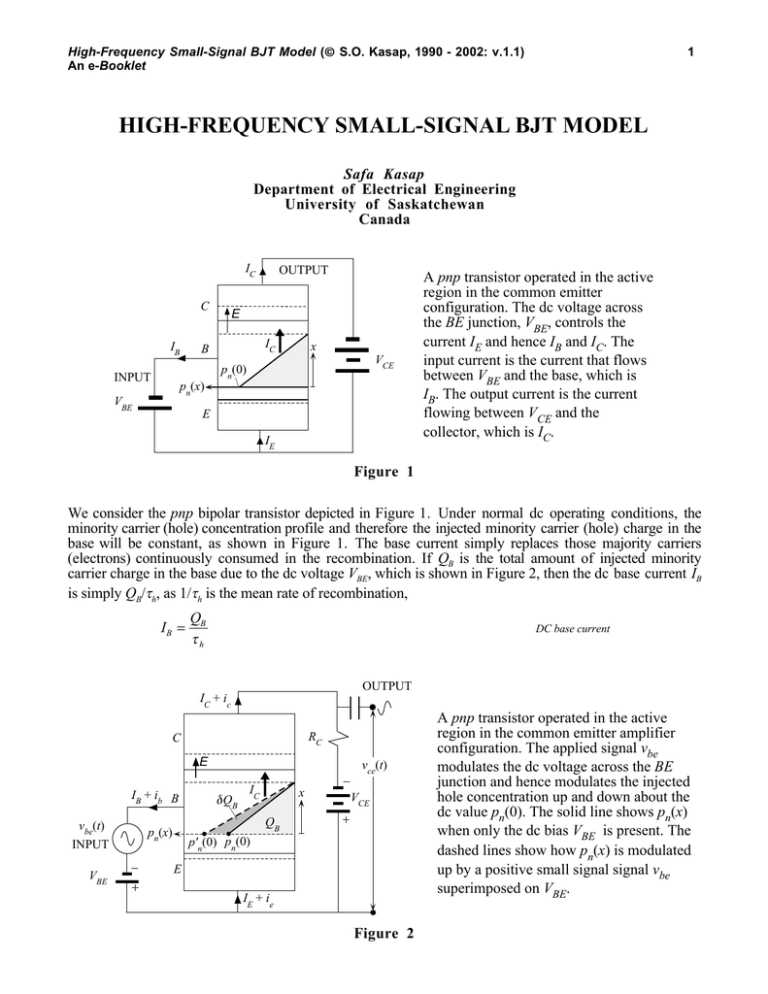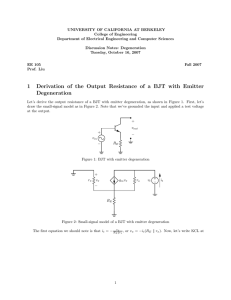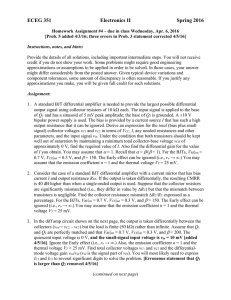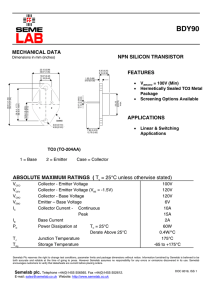
S.O. Kasap, 1990 - 2002: v.1.1)
High-Frequency Small-Signal BJT Model (
An e-Booklet
1
HIGH-FREQUENCY SMALL-SIGNAL BJT MODEL
Safa Kasap
Department of Electrical Engineering
University of Saskatchewan
Canada
IC
C
IB
OUTPUT
E
IC
B
x
VCE
pn(0)
INPUT
pn(x)
VBE
E
IE
A pnp transistor operated in the active
region in the common emitter
configuration. The dc voltage across
the BE junction, VBE, controls the
current IE and hence IB and IC. The
input current is the current that flows
between VBE and the base, which is
IB. The output current is the current
flowing between VCE and the
collector, which is IC.
Figure 1
We consider the pnp bipolar transistor depicted in Figure 1. Under normal dc operating conditions, the
minority carrier (hole) concentration profile and therefore the injected minority carrier (hole) charge in the
base will be constant, as shown in Figure 1. The base current simply replaces those majority carriers
(electrons) continuously consumed in the recombination. If QB is the total amount of injected minority
carrier charge in the base due to the dc voltage VBE, which is shown in Figure 2, then the dc base current IB
is simply QB/τh, as 1/τh is the mean rate of recombination,
IB =
QB
τh
DC base current
OUTPUT
IC + ic
RC
C
E
IB + ib B
vbe(t)
INPUT
VBE
vce(t)
QB
IC
x
VCE
QB
pn(x)
p'n(0) pn(0)
E
IE + ie
Figure 2
A pnp transistor operated in the active
region in the common emitter amplifier
configuration. The applied signal vbe
modulates the dc voltage across the BE
junction and hence modulates the injected
hole concentration up and down about the
dc value pn(0). The solid line shows pn(x)
when only the dc bias VBE is present. The
dashed lines show how pn(x) is modulated
up by a positive small signal signal vbe
superimposed on VBE.
S.O. Kasap, 1990 - 2002: v.1.1)
High-Frequency Small-Signal BJT Model (
An e-Booklet
2
Suppose that we now increase VBE by δVBE, which leads to an increase in pn(0) to p' n(0), which is
shown as the dashed line in Figure 2. With more minority carriers injected, there is now an additional
stored charge in the base, as indicated by the gray shaded area and labeled as δQB in Figure 2. Since the
stored charge, QB, in the base depends on V BE, there is a capacitive effect appearing between the BE
terminals. We represent the capacitive effect across the base-emitter terminals by defining a small-signal
diffusion1 (or storage) capacitance, Cdiff, by
Cdiff =
δQB
δVBE
Base diffusion capacitance
The stored charge, neglecting recombination, as shown in Figure 2, is
eV
1
1
eAWB pn (0) = eAWB pno exp BE
kT
2
2
Differentiating this with respect to VBE we obtain
QB =
Cdiff =
eQB eτ h I B τ h eIC τ h
=
=
=
kT
kT
βkT rbe
where we have used
rbe =
βkT βkT
≈
eIE
eIC
This is the capacitance that has to be charged and discharged as the signal v be modulates V BE. Its value is
generally greater than the capacitance of the BE depletion region. For example, typically, for a transistor
with β = 100 and a minority carrier lifetime of 1 µs, when IC = 1 mA, rbe = 2.5 kΩ and
Cdiff =
τ h 10 −6
=
= 0.4 nF
rbe 2500
There is also the capacitance of the depletion region, C dep, between the base and the emitter. Its
value for an abrupt junction was derived during the treatment of the pn junction and depends on the width
of the BE depletion region, WBE,
Cdep =
εA
WBE
where WBE decreases with increasing VBE. The total small-signal capacitance across BE is therefore
Cbe = Cdiff + Cdep
The small signal equivalent circuit of the BJT must therefore also include the capacitance C be, as
shown in Figure 3 (a). As the base-collector junction is reverse biased, there is, in addition, a depletion
region capacitance between the base and the collector terminals, which is shown as Cbc in Figure 3 (a). It is
apparent that Cbc provides a feedback path for the output current into the input, which, generally,
deteriorates the gain of the BJT amplifier.
1
The stored charge in the base is due to the diffusion of injected minority carriers in this region.
S.O. Kasap, 1990 - 2002: v.1.1)
High-Frequency Small-Signal BJT Model (
An e-Booklet
AC source
S
Small signal equivalent circuit
Cbc
ib
B
Rs
vs
S
Load
C
ic = gmvbe
Cbe
vin vbe
3
vce
rbe
E
RC
E
(a) The small-signal model including storage and
depletion region capacitances.
S
B
ib
Rs
vs
vin vbe
S
Cb'c
rbb' B'
vb'e
rb'e
C
ic = gmvb'e
Cb'e
E
rce
vce
RC
E
(b) The high frequency small-signal model including
storage and depletion region capacitances and base
spread and collector-emitter resistances.
Simplified small-signal HF model of the bipolar transistor in the CE
configuration.
Figure 3
The structure and geometry of nearly all bipolar transistors is such that recombination invariably
occurs over a region rather than at one specific location. Figure 4 shows a simplified schematic sketch of a
typical pnp BJT fabricated by the commonly used planar technology. It is apparent that the device is not
symmetric. The surface area of the collector junction is larger than that of the emitter junction. We define
the active base region as the volume of base that contains the majority of the emitter to collector hole
current, which is indicated (only roughly) in the figure. The base current has to supply electrons to the
closest and farthest points of recombination, which means that it flows over the whole active region of the
base, though its magnitude gets smaller farther away from the base terminal, B. Since the base material has
a finite resistivity, there is therefore a distributed voltage drop along the active region. In other words, the
voltage across the base-emitter, V BE, gets smaller as we move away from B. Thus the minority carrier
injection and hence IE gets less farther away from B. Suppose that point B ' is some mean point in the
active base region, as roughly shown in Figure 4, that represents an effective or a true base point
such that VB′E is the effective base-emitter voltage that controls the emitter current. Thus, by definition,
eV
IE = IEO exp B ′E
kT
Then we can calculate (or obtain by measurement) the effective resistance, say r bb′, of the base region,
which gives rise to the voltage drop VBE − VB′E:
VBE − VB′E = IB rbb′
S.O. Kasap, 1990 - 2002: v.1.1)
High-Frequency Small-Signal BJT Model (
An e-Booklet
4
where rbb′ is called the base spread resistance. It takes into account not only the distributed voltage
drop in the active base region due to flow of IB but also some of the base material outside the active base to
the base terminal, B. Figure 4 shows that rbb′ is placed between the base terminal, B, and the true base
point, B′, and has the base current, IB, flowing through it.
IB
E
Insulation (SiO2)
p
p+
n
B
B'
Nearly all the injected
minority carrier charge
is in this active region
IC
Electron
flow
Metallization
for contacts
IB r
bb'
Emitter to
collector hole
current line
C
A simplified representation of the structure of a typical pnp bipolar
transistor (for example, as fabricated by diffusion processes). The base
current flows through a finite semiconductor region to replenish the
electrons lost by recombination. It has to supply electrons to the closest
and also to the farthest point in the base. Point B' represents a mean
point in the active base region that acts as an effective base point.
Figure 4
pn(x)
pn(0)
Base
SCL
pn(x)
VCB = 5 V
VCB = 10 V
WB
WBC
W'B
W'BC
x
The Early effect. When the BC
reverse bias increases, the depletion
width WBC increases to W'BC, which
reduces the base width WB to W'B.
As pn(0) is constant (constant VEB),
the minority carrier concentration
gradient becomes steeper and the
collector current, IC, increases.
Figure 5
As B′ represents the true base point, the capacitances Cbe and Cbc involving the active base are now
between B′ and E, and B′ and C so that they become Cb′e and C b′c. The modified small signal equivalent
circuit is shown in Figure 3 (b). The model, in addition, has a resistance rce placed between the CE
terminals due to the following effect. Suppose that VBE is kept constant and VCE is increased by an amount
δ V CE. This increases the reverse bias VCB by δ V CB. Consequently the base width, W B, gets narrower as
S.O. Kasap, 1990 - 2002: v.1.1)
High-Frequency Small-Signal BJT Model (
An e-Booklet
5
shown in Figure 5 (due to the Early effect), which leads to a steeper minority carrier concentration gradient
and hence to a greater collector current, say by an amount δ IC. Since δVCE leads to δIC the two output
parameters are related just as they would be in a resistance. We define a small signal collector-emitter
resistance rce by
rce =
δVCE vce
≈
δIC
ic
The modulation of the base width W B by VCE is not very strong and hence δIC is generally very
small. Consequently rce is quite large, typically greater than 50 kΩ. It is represented as a resistance across
the CE terminals of the small signal equivalent circuit as shown in Figure 3 (b).
There are other effects, usually of secondary nature, in the small signal equivalent circuit which are
beyond the scope of this book. Their inclusion does not significantly affect the predictions of the model.
Small-signal equivalent circuits, such as that in Figure 3 (b), are most useful in obtaining the frequency
response.
For example, suppose that an ac source, v s , is connected across the base-emitter (in series with a
dc bias, which is not shown in small-signal equivalent circuits). We adjust v s so that the input current, i b ,
is always constant. What is the current gain, β, at different frequencies? The impedance between B′ and E,
zb′e, is given by rb′e and Cb′e in parallel. At low frequencies, we can neglect the impedance of Cb′e so that
there is only rb′e. The low-frequency gain, β, is then
ic gm vb©e
=
= gm rb©e = βo
vb©e
ib
rb©e
β=
Low frequency β
where by definition βo = gmrb′e and represents the low-frequency current gain.
At high frequencies, zb′e becomes shunted by the small impedance of Cb′e so that
1
jωCb ′e
zb ′e =
The magnitude of the current amplification at high frequencies is
β =
√2
High frequency β
The frequency dependence of the
current gain shown on a log-log
plot. The cutoff frequency is when
= o/√2.
o
log scale
o
g
ic gm vb©e
=
= m
v
©
ib
ωCb©e
be
zb©e
f
log scale
f
Figure 6
S.O. Kasap, 1990 - 2002: v.1.1)
High-Frequency Small-Signal BJT Model (
An e-Booklet
6
We see that the current gain decreases with the frequency in the high-frequency range. At high
frequencies, Cb′e shunts B′E and thereby reduces vb′e which results in a smaller output current, ic = g m v b′e.
The overall current amplification is shown in Figure 6, where the current gain exhibits a cut-off frequency
at ƒ = ƒ β, where its magnitude has fallen by a factor of 2 . This occurs when the impedance of Cb′e is
equal to rb′e
fβ =
1
β cutoff frequency
2πrb ′e Cb ′e
(1)
NOTATION
A
B
BJT
C
CE
e
E
E
f
gm
IB, IC, IE
k
pn(x)
area
base terminal BJT
bipolar junction transistor
collector terminal of BJT; capacitance
common emitter configuration
electronic charge (1.602 × 10-19 C)
electric field
emitter terminal of BJT
frequency
mutual transconductance
base, collector and emitter currents
Boltzmann′s constant (1.381 × 10-23 J K-1)
minority carrier concentration profile
QB
R, r
rbb′
T
V
V CC
WB
β
ε
π
τh
ω
total injected minority carrier charge in base
resistance
base spread resistance
temperature
voltage
supply voltage
base width
low-frequency gain
permittivity of a medium (C V-1 m-1 or F m-1)
pi, 3.14159...
mean rate of recombination
angular
frequency
USEFUL DEFINITIONS
Early effect (Base width modulation) is the modulation of the base width by the voltage appearing across the basecollector junction. An increase in the base to collector voltage increases the collector junction depletion layer width,
which results in the narrowing of the base width, hence increasing the collector current.
Base spread resistance (rbb′ ) is an effective resistance that represents the voltage drop from the external base terminal (B)
to the actual base point (B′). It is the voltage VB′E that controls the collector current.
Bipolar junction transistor (BJT) is a transistor whose normal operation is based on the injection of minority carriers
from the emitter into the base region and their diffusion to the collector, where they give rise to a collector current.
The voltage between the base and the emitter controls the collector current; this is the transistor action.
Majority carriers are electrons in an n-type and holes in a p-type semiconductor.
Minority carriers are electrons in a p-type and holes in an n-type semiconductor.
pn junction is a contact between a p-type and an n-type semiconductor. It has rectifying properties.
Recombination of an electron hole pair involves an electron in the conduction band (CB) falling in energy down into an
empty state (hole) in the valence band (VB) to occupy it. The result is the annihilation of the electron-hole pair.
Recombination is direct when the electron falls directly down into an empty state in the VB as in GaAs.
Recombination is indirect if the electron is first captured locally by a defect or an impurity, called a recombination
center, and from there it falls down into an empty state (hole) in the VB as in Si and Ge.
S.O. Kasap, 1990 - 2002: v.1.1)
High-Frequency Small-Signal BJT Model (
An e-Booklet
All material in this publication is copyrighted.
All rights reserved. No part of this publication may be reproduced, stored in a retrieval system, or
transmitted, in any form or by any means, electronic, mechanical, photocopying, recording, or otherwise,
without the prior written permission of the author.
Permission is granted to individuals for downloading this document from the author’s website or his
CD-ROM for self-study only, provided a copy of the second edition of the author's McGraw-Hill textbook
Principles of Electronic Materials and Devices, Third Edition, has been purchased or adopted as a requisite
course textbook. The permission is valid only while the book remains in adoption or it is in print.
SPECIAL CUSTOM PUBLISHED e-BOOKLET
S.O. Kasap, 1990-2002
The author reserves all rights
Last Updated: 27 November 2001 (v.1.1)
First published in Web-Materials
(Established 1996)
http://Materials.Usask.Ca
7






